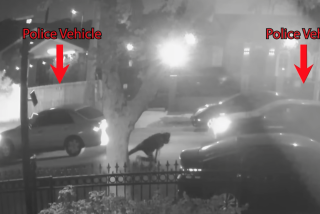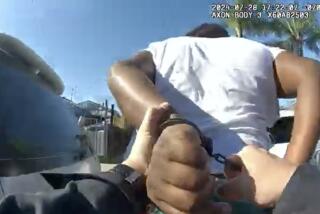Suspect Denies Carrying Metal Tool
A suspected car thief pummeled with a flashlight last week by a Los Angeles police officer denied Monday being in possession of metal wire cutters, challenging the officer’s claim that he beat the suspect after another policeman mistook the tool for a gun.
The black suspect, Stanley Miller, whose videotaped beating at the hands of a Latino officer has refocused national scrutiny on the Los Angeles Police Department, also reiterated an earlier claim that he never heard any officer yell “gun” and has no idea why he was beaten, Miller’s lawyer said after interviewing his client in County Jail.
“He had no wire cutters or any metal object whatsoever,” said the lawyer, Mark Werksman. “If [the police] came up with something, the information I’m getting is they either planted it on him or they’re making it up.”
Werksman said his 36-year-old client told him he was wearing baggy sweatpants with loose pockets that would not hold things securely. For that reason, he said, Miller was running with his possessions in his hands -- a cellphone in one hand, and a five dollar bill and three ones in the other.
“The burden is on the police to explain this apparently illegal excessive force,” Werksman said.
Officer John J. Hatfield, the patrolman who kicked and then struck Miller 11 times with his metal flashlight, told investigators last week that he delivered the blows to stun Miller after an officer trying to handcuff the suspect yelled that the man was armed with a gun, sources close to the investigation told The Times.
Police Chief William J. Bratton and other top LAPD officials have made no official comment on whether Miller was in possession of wire cutters or on any other aspect of the ongoing investigation.
One source familiar with the case scoffed at the notion that officers planted a pair of wire cutters on Miller as news helicopters hovered above the scene and numerous other officers milled about.
“These officers go in foot pursuit of a guy and they just happen to have a pair of wire cutters on them?” the source asked. “I mean come on -- it’s totally implausible.”
Court records show that Miller has convictions for car theft and attempted burglary. In one probation report he was described as a longtime crack-cocaine user.
According to police, officers noticed Miller driving a white Toyota Camry through a stop sign at Figueroa Street and Laconia Boulevard in South Los Angeles near the Harbor Freeway about 5:15 a.m. Wednesday. They checked the license plate and learned the car had been reported stolen.
When police tried to pull over Miller, he led them on a 28-minute chase. At the conclusion of the pursuit, Miller got out of the car and tried to escape on foot. Apparently out of breath, he finally raised his arms and appeared to surrender to an officer at gunpoint.
The officer then re-holstered his weapon and tackled Miller in an attempt to handcuff him. Seconds later another officer and Hatfield arrived at the scene to assist. Hatfield, allegedly responding to a fellow officer yelling “gun” as he felt a hard metal object in the suspect’s pants, is seen on videotape first kicking, then repeatedly striking Miller while the other two officers try to handcuff him.
Werksman said his client was shocked by the attack.
“He thought it was over when he saw the officer who commanded him to the ground put his gun away,” Werksman said, “which made the beating all the more mystifying.”
Laurie Levinson, a professor at Loyola Law School and former federal prosecutor, said any evidence that the police weren’t telling the truth about the incident could be devastating if the case resulted in criminal charges against one or more of the officers.
“Police are allowed to use force. But if they’re lying about why they’re using the force, jurors are less likely to believe that the force was required,” Levinson said. “If you have evidence that police officers tried to fabricate an excuse for hitting a suspect, that would be really compelling evidence of police misconduct.”
She cited the 1991 police beating of Rodney G. King as an example.
“What ended up making the case, as much as any other evidence, was the alleged cover-up,” she said.
More to Read
Sign up for Essential California
The most important California stories and recommendations in your inbox every morning.
You may occasionally receive promotional content from the Los Angeles Times.











